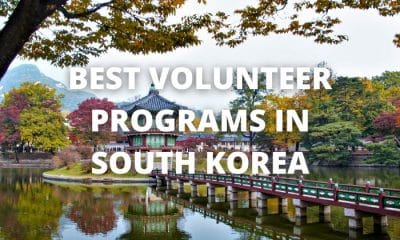Madagascar
Best Volunteer Programs in Madagascar
Join the transformative mission of Abroad Escape and embrace the extraordinary opportunity to make a difference in Madagascar! Embark on an unforgettable adventure as a dedicated volunteer and immerse yourself in the heart of this captivating Our distinguished volunteer…
Looking for the best volunteer abroad programs in Madagascar? Here is our list of the best volunteering programs in wonderful Madagascar.
Madagascar, the fourth largest island in the world, is a diverse and beautiful country with an ancient history. Despite being geographically isolated for many years, the country has retained a culture and biodiversity that is truly unique. However, the country’s 22 million people still face a lack of modernity. There is limited access to basic services, and poaching, redwood harvesting, forest degradation for farming, and charcoal production are a few of the threats to the country’s wildlife.
Join the transformative mission of Abroad Escape and embrace the extraordinary opportunity to make a difference in Madagascar! Embark on an unforgettable adventure as a dedicated volunteer and immerse yourself in the heart of this captivating destination. Our distinguished volunteer programs in Madagascar grant you the freedom to design a personalized schedule, allowing you to partake in the most fulfilling and influential projects this remarkable country has to offer. Prepare to embark on a voyage of a lifetime, where you will not only experience the thrill of exploration but also leave a lasting impact on the local communities of Madagascar.

Thrive Madagascar Volunteer Centre
The Thrive Madagascar Volunteer Centre is located in the capital of Antananarivo, which offers a comfortable place to stay and delicious meals. The centre’s staff is on hand to help you get to know Madagascar’s culture and safety practices. Volunteers have the option of learning the Malagasy language or assisting local residents with a variety of other tasks. Volunteers may also choose to volunteer in the area’s forests or at a sustainable farming initiative.
Volunteers working on conservation projects in Madagascar will benefit the local people as well as endangered species. Many of these species are based on the island nation’s coast, and volunteers can help protect these unique habitats. Thrive Madagascar Volunteer Centre has a wide range of projects, including those in community development, turtle conservation, and marine conservation. The volunteer program fees are affordable, and Thrive Madagascar offers projects from top-rated organizations.
The staff is committed to helping the Volunteers succeed. They help with administrative work and technical trainings in order to empower and motivate them to do their best in their chosen field. In addition to helping Volunteers with their work, they also provide language classes. As a result, Feno was able to improve his English language skills while teaching American Volunteers about his country and its culture.
IMPACT Madagascar
IMPACT Madagascar is a great option for anyone looking to make a difference in Madagascar. The program focuses on helping local communities in a way that is both beneficial for the community and environmentally responsible. Volunteers will receive scientific training and orientations as well as receive the chance to experience local culture and life. Because of this, participants will feel more like locals than tourists.
IMPACT Madagascar’s office is located in Nanisana, a quiet neighborhood in Antananarivo. This is a great location for volunteers because it is near local markets and restaurants. It also offers a comfortable place to stay if you prefer it. In addition to this, you can also stay in one of the IMPACT Madagascar sites, which are located in the northwest region of Madagascar.
The staff of IMPACT Madagascar is available round-the-clock, and you can expect them to be there for you at all times. Volunteers can participate in various activities and contribute to conservation efforts. Some projects may involve environmental protection, conservation of wildlife, animal welfare, or artistic or musical development. Others may involve working in rural communities or with animals.
Volunteers at IMPACT Madagascar will contribute to conservation projects on the island, including marine conservation and the preservation of coral reefs. Volunteers will help local staff implement projects in remote regions of Madagascar, and will gain insight into Malagasy culture and natural kindness.
Whether you’re looking to make a difference for local communities or simply to get some valuable experience while giving back to the community, volunteering in Madagascar will provide you with an experience unlike any other. The experience is also a great way to make friends and explore new cultures.
Madagascar is one of the world’s most threatened countries. The island is home to 5% of the world’s plant and animal species, including lemurs, which are endangered due to deforestation. There are many ways to help the lemurs and other wildlife, and volunteering in these areas can make a big difference in the long-term survival of the species.
IMPACT Madagascar is one of the best opportunities for conservation work in Madagascar. Volunteers can help with local initiatives and environmental education while helping to preserve and develop native forests. During the course of their program, volunteers will also plant saplings, plant nurseries, and educate local children about sustainable practices.
Go Volunteer Africa
There are several options available for volunteers in Madagascar. One of the best is the Lemur conservation program with African Impact, which takes place in the Sainte Luce Reserve in southeast Madagascar, one of the last areas of coastal rainforest left intact. Volunteers will work alongside local staff and help with environmental education and community initiatives. They will plant trees and nurseries, and teach children sustainable practices. The program costs PS795, or about $1100.
Volunteering in Madagascar is a rewarding experience that is sure to leave a lasting impression. The country has a unique flora and fauna and is an ideal destination for outdoor enthusiasts. By volunteering in Madagascar, you’ll be contributing to protecting nature and improving the lives of the locals.
Go Volunteer Africa’s top volunteer programs value input from local communities and carefully analyze volunteer placements. Better-matched volunteers are more effective. Moreover, they evaluate the skills of their volunteers to tailor their experience to the needs of each region. The program’s graduates rate is a testament to its quality, with 95 percent five-star alumni reviews.
Madagascar has a rich biodiversity and culture. It is the fourth largest island in the world and is home to 18 different ethnic groups. Its people are open and friendly. The country is located at the crossroads of the African and Asian worlds. Your experience in Madagascar will forever change your perspective on the world.
Choosing a volunteer program in Africa can be a challenging task. There are so many volunteer opportunities available that choosing the right type for you can be even more difficult than choosing where to volunteer. Make sure to do your research and pick the program that is right for you. You’ll be glad you did.
Projects Abroad
Volunteering in Madagascar offers a unique experience, where you’ll get to work alongside local people and contribute to ongoing programs. There are several different opportunities to participate in, including projects that focus on education, business development, and wildlife conservation. There are also opportunities to explore the unique culture of the country.
Madagascar is an island nation that faces serious challenges. Volunteers can help protect lemur habitat, provide medical care to underserved communities, and raise awareness of important health issues. In addition, they can make new friends from around the world. With the many volunteer opportunities in Madagascar, you’ll be able to find a program that fits your interests and schedule.
Volunteers in Madagascar can join projects in the capital Antananarivo, or in remote areas. The city of Fianarantsoa is a popular location for volunteer projects. There are programs that focus on wildlife conservation, environmental protection, arts and music, and rural community development.
Volunteers can also volunteer in the islands of Madagascar. Nosy Komba is a volcanic island that is located between Nosy Be and the northwest coast. Volunteers can participate in a 10-day eco-project where they learn about the island’s indigenous forests and wildlife.
While volunteers are in Madagascar, they’ll also learn about the country’s unique culture. The island is also home to an amazing diversity of flora and fauna, including lemurs and exotic birds. They’ll be able to help conserve the island’s forests and investigate the condition of indigenous forests.
Volunteers can also help with teaching projects in Madagascar. While there’s no need to be an expert in education or teaching, native English and French speakers can be invaluable resources for local teachers. Volunteers can also help with preparing homework and marking pupils’ work. Some volunteers work in schools, while others help to build new schools.
Madagascar
Volunteer Madagascar
Join the transformative mission of Abroad Escape and embrace the extraordinary opportunity to make a difference in Madagascar! Embark on an unforgettable adventure as a dedicated volunteer and immerse yourself in the heart of this captivating Our distinguished volunteer…
Volunteering in Madagascar is an opportunity to explore an incredible country and get involved in its development. You will learn about the Malagasy culture and help preserve the island’s wildlife. Volunteers also receive scientific training and orientation before their program. As a result, they will be more like locals than tourists.
Join the transformative mission of Abroad Escape and embrace the extraordinary opportunity to make a difference in Madagascar! Embark on an unforgettable adventure as a dedicated volunteer and immerse yourself in the heart of this captivating destination. Our distinguished volunteer programs in Madagascar grant you the freedom to design a personalized schedule, allowing you to partake in the most fulfilling and influential projects this remarkable country has to offer. Prepare to embark on a voyage of a lifetime, where you will not only experience the thrill of exploration but also leave a lasting impact on the local communities of Madagascar.

Why volunteer in Madagascar?
Madagascar is a country with a large need for volunteers. The country has a population of 22 million, and over half of them live below the poverty line. There are many ways to help the Malagasy people improve their lives, including infrastructure and healthcare. If you speak the Malagasy language, you will be warmly welcomed by the locals and likely be able to find work more easily.
There are numerous volunteer projects in Madagascar, and there are many ways to help. You can join programs in the capital city of Antananarivo or the country’s remoter areas. There are also projects focused on education and arts, and you can even get involved in animal projects. While working on the volunteer project, you’ll make new friends and have a chance to see a different side of Madagascar.
Madagascar is a fascinating destination, with a rich biodiversity and a cosmopolitan society. It’s one of the poorest countries in the world, but the people are friendly and generous. They are also proud of their culture and what they have, which is why many volunteers choose to work in Madagascar.
If you’re a wildlife lover, you’ll love Madagascar’s unique environment. Its coral reefs and underwater worlds make it a prime location for unique species. Volunteers can help protect these ecosystems by conducting research and monitoring changes. Their work will also raise awareness of conservation efforts on the island.
The country’s natural beauty is unparalleled. There are baobab trees in the wild and nearly 100 species of lemurs. And its people are warm and welcoming. However, the country is in desperate need of rain – a lack of rainfall can cause crops to fail, and the lack of rain causes widespread malnutrition. Consequently, the country’s drinking water supply is threatened.
Why Travel to Madagascar?
Volunteering in Madagascar offers the chance to make a difference in an underdeveloped country. While this island nation is one of the most biodiverse on Earth, it is also one of the poorest economically. Over seventy-three percent of the Malagasy population lives below the poverty line. Despite this disparity, Malagasy society is warm and welcoming. Unlike other African countries, Madagascar’s people aren’t hostile toward volunteers and are generally delighted to help.
Volunteers are required to be at least 18 years old, but exceptions can be made on a case-by-case basis. Ideal candidates for this type of work are self-motivated, flexible, and willing to immerse themselves in the local culture. Volunteers usually live in a shared volunteer house, with rooms shared by gender. Meals are a mix of Western and Malagasy cuisines, and you’re free to cook your own meals or eat out at your own expense.
Volunteering in Madagascar is a wonderful way to give back to the country and experience a life-changing experience. It will give you the opportunity to help protect critically endangered species while improving the lives of locals. It will also open your eyes to a fascinating culture and landscape. You’ll be able to witness firsthand the diversity of plant and animal species that call Madagascar home.
Volunteers working in Madagascar can choose from a variety of projects, including those that involve healthcare. Some of the most common projects involve designing mobile medical units. Volunteers can help combat malnutrition in children and improve maternal health. Volunteers can choose to stay for a short time or as long as they’d like. The most in-demand skills are those related to healthcare, but people with backgrounds in development, environmental and social sciences are also welcomed.
Madagascar has a diverse population. About half of its people live below the poverty line, so there are many volunteer opportunities available that can make a huge difference to their lives. Many organisations in Madagascar need volunteers to redistribute animals and manage forests. Other projects need volunteers to educate local government about conservation issues.
Volunteer Opportunities in Madagascar
Volunteer Opportunities in Madagascar are plentiful, and there are many ways to get involved. Many projects require volunteers to be at least 18 years of age, although exceptions can be made on a case-by-case basis. Volunteers are also expected to be flexible and hardworking, with the desire to immerse themselves in the local culture. Volunteers stay in volunteer houses in both rural and urban areas. Volunteers are accommodated in shared rooms, and meals are a combination of Western and local cuisine. Some projects also provide a kitchen, allowing volunteers to cook their own meals. However, if this is not an option, volunteers may also choose to eat out at their own expense.
Volunteering in Madagascar can be an incredible experience. Whether you want to help the local people, protect the environment, or develop musical skills, there are opportunities to fit your interests. Volunteering in Madagascar is a great way to meet new people and see new cultures. There are many different international and local volunteering opportunities to choose from in Madagascar, so you’re bound to find one that’s right for you.
If you’re interested in gaining professional experience, Madagascar’s teaching programs are ideal for those looking to develop their teaching skills. In addition to teaching native English and French to local children, volunteer placements in Madagascar may also involve assisting with homework assignments and marking pupils’ work. Some programs may even involve working with local teachers to create lesson plans.
Volunteers can help protect the marine environment and contribute to the restoration of endangered species. Volunteers can take part in several conservation projects and study the ecosystem’s health and diversity through snorkel surveys and forest walks. These projects also help to protect the region’s coral reefs.
Why join Volunteer Programs in Madagascar?
Volunteers can choose from a variety of volunteer projects in Madagascar, including those focused on conservation efforts, animal welfare, and artistic and musical development. These volunteer projects can help protect the island’s flora and fauna and improve the lives of the local population. The best part is that there is no cost involved.
Most volunteer programs in Madagascar are held during the summer, when most tourists visit the country. This time is ideal for immersion in local life. Volunteers can work in guesthouses or rural communities, learning the language and making lifelong friends. Volunteers stay in volunteer houses, sharing rooms with other volunteers, and meals are usually a mixture of Malagasy food and Western fare. Volunteers may also choose to cook meals for themselves or eat out at their own expense.
Volunteers in Madagascar can help the local population with medical care and infrastructure. The population of Madagascar is 22 million and 50% of people live below the poverty line. Volunteers can help improve lives in Madagascar by working in rural projects. Some of these programs can be arranged through a charity organization such as Mada Clinics.
Volunteers can also help conserve the island’s marine life. The island’s mangroves are under threat from overfishing and urbanization. Volunteers may also contribute to environmental education and community initiatives, helping to protect the area’s forests and wildlife. Volunteers can even help establish nurseries, plant saplings, and educate local children about sustainable practices.
Volunteers from different backgrounds can contribute to the community in many ways. The most sought-after skill is healthcare, although volunteers from all backgrounds are welcome. Other areas include development, social welfare, and environmental conservation. Volunteers can stay as long as they wish, as long as they have the necessary skills and interest.
Volunteers in Madagascar can learn about the country’s unique natural history and biodiversity. The island is home to nearly 200 different animal species, with over one-fifth of them being endemic. Many of these animals are in danger of extinction, but many organizations are working hard to protect their habitats and wildlife.
Madagascar
Best Time to Visit Madagascar
The best time to visit Madagascar is between January and mid-March. These months are cheaper and there are fewer tourists, but Madagascar is muddy and rainy, so you’ll want to bring easy-to-dry clothing and rain gear. You should also bring mosquito repellent, germ killers, a waterproof flashlight, and plastic bags. June is the low season, when rice crops are planted in the highlands.

March
During March, the weather is hot and humid but pleasant. The highlands are a deep gold and the plains and valleys are covered with rice fields. You’ll find plenty of opportunities for hiking and sightseeing. There’s also a lot of festive spirit. March 29 is also a memorial day for the 1947 uprising, in which hundreds of thousands of Malagasy people died in the face of the French colonial administration.
The climate in Madagascar is tropical. While the wet season begins in November and lasts until March, the dry season begins in April. The climate is milder away from the rainforest, with average temperatures of 25 degrees inland and 30 degrees on the coast. The cyclone season occurs in February and March. However, wildlife encounters are possible all year round. If you are planning to see whales, you’ll be more likely to encounter them between April and May.
If you’re planning on visiting the island in the middle of the rainy season, you’ll be lucky to find a sunny day. Although Madagascar has unpredictable weather, rains in the first three months are common, with January and February being the wettest months. This means that rains can be heavy and roads can become impassable. Cyclones can also strike the island in February, causing significant damage to roads and riverbanks. You should avoid traveling to the east coast during this period.
The best time to visit Madagascar is between April and October. During the dry season, temperatures are cooler and brighter, which make it the ideal time to hike, snorkel, and dive. You’ll also have better chances of seeing baby lemurs and other wildlife during this time.
April
April is the best time to visit Madagascar for the best weather conditions. This season offers cooler temperatures and low rainfall making it an ideal time for outdoor activities like hiking, snorkeling, diving, and surfing. It’s also the best time to see baby lemurs and other wildlife. You’ll have fewer problems finding accommodation during the dry season.
Regardless of the season you choose to visit Madagascar, it’s important to understand its climatic conditions. The island is separated into distinct climate zones, which are characterized by extremes of temperature. Highlands, where rain occurs year-round, are often cold and wet, especially during the night. Those who are hiking should bring layers to stay warm. Also, the northeast of the island receives heavy rains during the rainy season. During this season, you can visit areas such as Baie d’Antongil and the Masoala Peninsula. While these are cooler than the rest of the island, they are still beautiful and safe to explore.
If you plan to travel to Madagascar during the low season, you can enjoy a great deal of discount travel during this period. However, it is still rainy in April, so road travel will be difficult, and some hotels and lodges may be closed. Additionally, the roads will be very wet, and the rainy season also means that the National Parks will be closed during this time. But even if the weather isn’t ideal, April is still the best time to visit Madagascar.
The weather is ideal for whale watching, with the whales still lingering off the coast. October is also a fantastic time to go birdwatching, with many species of birds displaying their vibrant plumage. Andasibe – Mantadia is a great place to see baby lemurs. You can also go bird-watching in Tsingy de Bemaraha.
December
The rainy season is December to February and it is the best time to visit Madagascar if you are looking for greenery in the highlands and mountainous areas. The rainy season in Madagascar is the worst, so you are likely to be soaked, but you can still enjoy sunny days. You can visit Toliara and Antsiranana for pleasant weather.
The dry season is from April to October. The temperatures remain comfortable and sunny with low to mid-70s. It’s also the best time to visit Madagascar if you’re interested in trekking, diving, or snorkeling. During this time, you’ll have the best chance of seeing the lemurs and other wildlife.
The rainy season is over in March, with rain showers becoming rare. From April to May, Madagascar is in its austral winter, which means that it’s dry and mild throughout the country. Many people consider April to May to be the best time to visit Madagascar, as the days are sunny, and the evenings are cool enough to enjoy sightseeing. However, the west and north of Madagascar experience the hottest weather.
For photographers, October and November are excellent months to visit Madagascar. The birds are in the mating season during this time, and their colorful plumage makes for stunning photos. You’ll also have the best chance to spot humpback whales during October and November. While the wet season can create problems while traveling, the best time to visit Madagascar during these months will ensure you have the best chance of seeing them.
The shoulder seasons in Madagascar are from July to October. These are the transitional seasons between winter and summer. During these months, temperatures are slightly cooler and the days are longer. However, the weather in northern Madagascar is a bit wetter than in the south. In addition, the rainy season is over, but some parts of Madagascar still remain largely obstructed by poor road conditions.
July
There are a few benefits to visiting Madagascar during July. For one, the weather is relatively pleasant. There is less rain and temperatures are lower than in other months. Secondly, many hotels are closed, so you will be able to avoid the crowds. In addition, you will get the best price for flights and accommodations during this time.
While the weather is cooler in the highlands, July is a great time to see the country’s beautiful landscapes. Rice fields are in bloom and the highlands are covered with lush greenery. The weather is also a lot brighter than during the other months. For those who love taking photographs, this is the best time to visit Madagascar. The lush green vegetation provides the perfect backdrop for photographs.
July is also a great time to visit Madagascar if you plan to go whale-watching. The waters are calm and the whales are just offshore. It’s also a great time for birding, as the bird breeding season is in full swing. October is also quieter than September, making it a great time to observe Madagascar’s wildlife.
While the weather in Madagascar can be pleasant year-round, April to October are the prime months. The country experiences fewer rain showers, making it an excellent time for sightseeing, hiking, and participating in water sports. The roads are also clearer during this time. While the weather is warm during the dry season, accommodation rates are higher.
August
While August is not the peak tourist season for Madagascar, this is the drier, cooler season of the island. You can still expect some rain during this time, but it will be less frequent. In fact, you may see fewer tourists during this time because of the lowered temperatures. In addition, the roads will probably be wet and difficult to navigate. However, you will find that prices are still reasonably priced.
You can expect a milder climate in August than in July, so it is still a good time to go on a safari. This is also whale-watching season, so you can see humpback whales and other marine animals swimming around. Coastal snorkelling is also fantastic during this month, when you can observe tropical fish.
There are many benefits to visiting Madagascar during this time of year. The days are mild, with temperatures averaging around 25 degrees Celsius, making it a good time to go hiking and see wildlife. Temperatures are also at their highest in the north and west coasts, but nights can be cool in the south. Also, in August, the central highlands celebrate Famadihana, a two-day family exhumation ceremony that includes dancing and music.
You can also visit the island in the rainy season. While this is not the best time for travel, the climate is still pleasant, and you can enjoy the lush greenery of the mountains and valleys. While the rainy season can be a little unpredictable, the sun will still shine at some point.
The best time to visit Madagascar is in August. It is the peak tourist season for the island, so it is recommended to book early. However, you must be prepared for strong winds on the east coast, which can impede scuba diving. Additionally, the lowland rainforests are less active during this time.
Madagascar
Best Places to Visit in Madagascar
If you’re planning a trip to Madagascar, there are a number of the best places to see. These include the Avenue of the Baobabs, Tsingy de Bemaraha National Park, Maroantsetra National Park, and Kirindy Forest. These places are the highlight of any trip to Madagascar.

Tsingy de Bemaraha
If you love nature and the great outdoors, Madagascar is the place to be. Tsingy de Bemaraha is one of Madagascar’s most spectacular parks. Located 20km from Bekopaka, this nature reserve is home to limestone peaks that are up to 50 metres high. This place is a UNESCO World Heritage Site and is a must see for anyone visiting the island.
The Tsingy de Bemaraha National Park is renowned for its rugged terrain, making it a great place for hiking. It features several hiking circuits ranging in difficulty from easy to difficult. It is best to have a qualified trekking crew with you to ensure you have a safe, enjoyable trek. There are two hiking trails that are particularly popular in this park.
The best time to visit the park is from April to November, when roads are passable. During the rainy season, the roads become impassable and the park is closed. However, during the dry season, heavy rains begin to die down and the roads become navigable.
If you’re looking for a more comfortable place to stay during your visit to Madagascar, consider staying in one of the many camps in the area. Many of them have hot running water and have good meals. Some camps even allow you to bring your own tent! The price is reasonable, and it’s a great option if you’re budget-conscious.
Maroantsetra
Located in north-east Madagascar, Maroantsetra is the gateway to Nosy Mangabe and Masoala National Park. The town has a thriving market and muddy streets lined with lean-to tin shacks. You can go diving, snorkeling, or hiking to explore the rich marine life.
To get to Maroantsetra, you can fly from Toamasina or Sambava. The trip will take about three hours. You’ll want to buy tickets ahead of time for the park. Alternatively, you can book your trip through your hotel or local travel agency.
Maroantsetra is also home to the Nosy Mangabe island. It is an island covered in rainforest trees from sea to summit, and there are flocks of white egrets that call this island home. You can spend a day here and then continue your Madagascar adventure from there.
There’s an array of animal life to see, including lemurs and birds. There’s also a wide variety of plants to see. For hiking enthusiasts, you can head to the Avenue of the Baobabs to admire the majestic baobab trees. If you’re into hiking, Tsingy Rouge Park and Tsingy de Bemaraha Strict Nature Reserve provide excellent trails.
Avenue of the Baobabs
The Baobabs are a wonder to behold. They grow as old as 800 years and are renowned for their beauty. The avenue is best visited at sunrise or sunset. The early morning and early evening light are ideal for photography as there is a mix of foggy rays and clear horizons. The best time to visit is in the early morning, when the baobabs are less crowded and the long shadows of the trees are ideal for photography.
Most tourists choose to visit the Avenue of the Baobabs by tour bus. There are different tours available and the cost will vary. The cost for a bus tour can range from four to ten dollars for a straight trip. Baobabs are unique because only six species of these trees grow in Madagascar. Though their numbers are declining due to climate change, they have survived remarkably well in spite of this.
The Avenue of the Baobabs is an iconic place in Madagascar and a must-see attraction. This 260-metre long avenue is home to some of the largest baobab trees in Africa. The trees were once part of a vast deciduous forest. However, the expansion of the population caused mass deforestation in the area. Most of the trees are now dead, but a few still stand.
The Avenue of the Baobabs is located in western Madagascar and is around 40 minutes’ drive from the town of Morondava. The famous avenue of the Baobabs is lined with 25 huge Grandidier’s Baobab trees.
Kirindy Forest
If you want to experience the wild side of Madagascar, Kirindy forest is one of the best places to visit. This forest is located on the western coast of Madgascar, 60 km north of Morondava. The park is accessible by road, which passes the Avenue of Baobabs, a prominent group of baobab trees.
This forest is home to a variety of animals, including the Malagasy Giant Rat. This unique species is the only living member of its genus, and can jump nearly 40 inches into the air when threatened. Its appearance during the night is guaranteed to wake you up, and you’ll be able to capture some unforgettable photos.
Kirindy is a private conservancy and research center. Visitors come primarily to view the fossa, the smallest primate in the world. But there are also many endemic plant species, including the Grandidier’s baobab, the largest of the six species of baobabs in Madagascar. In addition to its diverse ecosystem, Kirindy has a warm tropical climate with short rainy seasons and a dry, hot season. During the dry season, temperatures are cooler at night and drier in the day, which makes it an ideal time to explore the forest. During this period, you can also observe the fossa in the ecolodge.
Located in south-western Madagascar, Kirindy is home to a wide variety of lemurs, including the endangered Berthe’s mouse lemur. This park also boasts one of the highest concentrations of fossas on the island. The park also contains a large population of nocturnal lemurs, which are Fossa’s main food source.
Andasibe-Mantadia National Park
One of the most accessible national parks in Madagascar is Andasibe-Mantadia, which spans 150 square kilometers of rainforest. The park features a diverse array of plants and animals. Hiking is especially popular during the dry season, between April and August. Birdwatchers will also enjoy the park in September and December, when many migratory species are in season.
This beautiful park is just a three-hour drive from Antananarivo and is a nature lover’s paradise. With its lush, luxuriant forest, you’ll have the opportunity to observe a variety of lemur species. The park is also home to numerous bird species, including the blue coua and the nuthatch vanga.
This park is home to more than 100 species of endemic birds. You can spot many of these species during guided hikes through the park. The best parts of the park for hiking are the Analamazaotra and Mantadia sections.
You’ll have a great chance to see some of the world’s most unique animals. In particular, the Andasibe National Forest Park, the largest in Madagascar, is home to many chameleons, giant bats, and other unique animals. The park is a true natural zoo.
The Avenue of the Baobabs is a striking landscape in western Madagascar. It’s a perfect location for those who like to snorkel. The park is also home to three marine parks.
Ambatolampy
For the most part, Ambatolampy has a tropical climate. The cool season lasts for about 2.3 months and the average high temperature is below 67 degrees F. The coolest month is July, and the hottest month is December. The average low temperature in Ambatolampy is 46 degrees F, and the highest is 64 degrees F. The temperature is represented in the map below as thin dotted lines. The bands indicate the perceived temperature at different times of the day.
If you have time to travel to Madagascar, you should consider visiting Ambatolampy. It is a picturesque town surrounded by beautiful rivers and streams. The area is known for trout farming, which is an important industry in the area. It is a popular destination for hikers because of its cool temperature.
Ambatolampy is also known for its aluminium foundries. These factories still use traditional methods of making wares. You can take home unique souvenirs made of the metal, which was originally used to make cans. The town is also a center for recycling. The local community collects and melts down scraps of aluminium, so many objects made here are recyclable.
The average temperature in Ambatolampy varies slightly. The shortest day of the year is June 21 and the longest day is December 22. The average hourly wind speed is over 6 miles per hour in July, while the hottest month is November. The prevailing wind direction is east throughout the year.
-

 South Korea2 years ago
South Korea2 years agoBest Volunteer Programs in South Korea
-

 Freiwilligenarbeit im Ausland2 years ago
Freiwilligenarbeit im Ausland2 years agoFreiwilligenarbeit Thailand
-

 Adventure Travel2 years ago
Adventure Travel2 years agoWhat Are the Challenges of Adventure Tourism?
-

 Volontariat à l'étranger2 years ago
Volontariat à l'étranger2 years agoVolontariat Thaïlande
-

 Vrijwilligerswerk2 years ago
Vrijwilligerswerk2 years agoVrijwilligerswerk Thailand
-

 Freiwilligenarbeit im Ausland2 years ago
Freiwilligenarbeit im Ausland2 years agoFreiwilligenarbeit Laos
-

 Adventure Travel2 years ago
Adventure Travel2 years agoTypes of Adventure Tourism
-

 Vrijwilligerswerk2 years ago
Vrijwilligerswerk2 years agoVrijwilligerswerk Laos






















